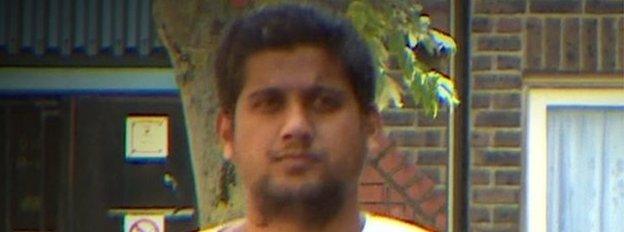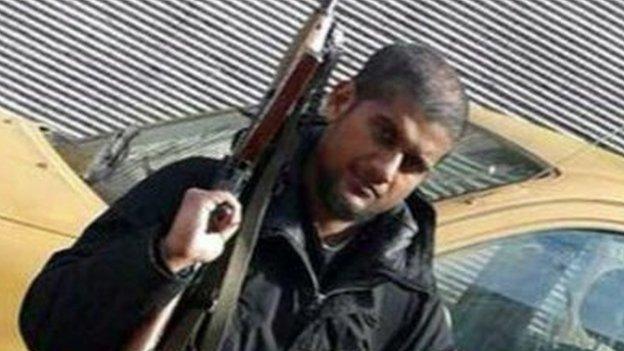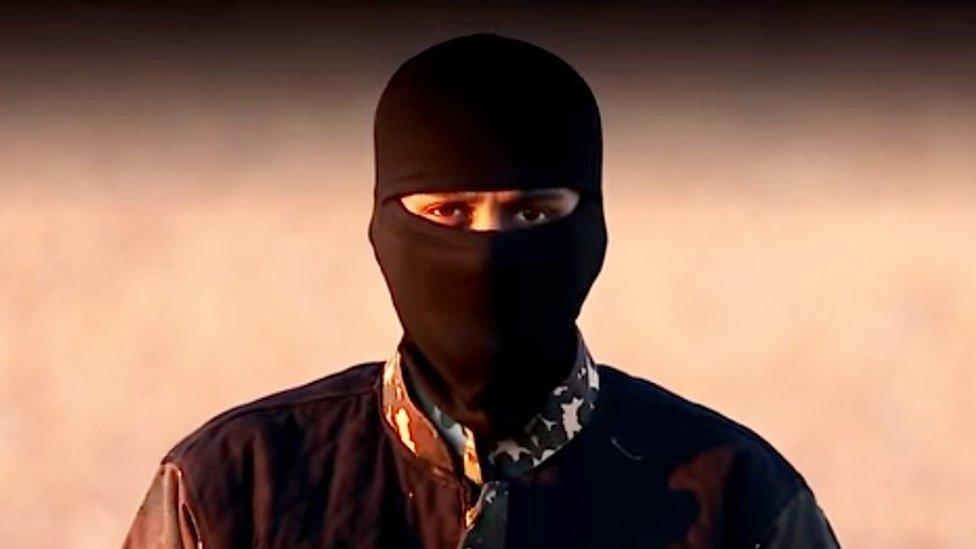Islamic State video suspect thought to be Briton Siddhartha Dhar
- Published
Siddhartha Dhar participated in a BBC debate - broadcast in August 2014
The main suspect in the latest propaganda video by so-called Islamic State is thought to be British man Siddhartha Dhar, the BBC understands.
An official source told the BBC Mr Dhar was the focus of investigations into the video, which purports to show the killing of five men IS says were spies.
"A lot of people think it is him," the source said, although there has been no official confirmation.
Mr Dhar, also known as Abu Rumaysah, fled Britain in 2014 while on bail.
The father-of-four, from Walthamstow in east London, had been arrested on suspicion of encouraging terrorism, but later travelled to Syria.
Siddhartha Dhar's sister, Konika Dhar: "Audio resembles voice of my brother... but I wasn't entirely convinced"
The UK's security authorities are facing mounting questions over how he was able to flee the UK while on bail, one of the conditions of which was that he must hand over his passport.
Shadow home secretary Andy Burnham described it as a "serious lapse in security" and called for an inquiry.
He has been granted an urgent question in the Commons later on Tuesday about how Mr Dhar managed to flee the UK.
Labour MP Keith Vaz, chair of the Home Affairs Select Committee, said a separate investigation was unlikely but the issues would form part of his committee's counter-terrorism inquiry.
'Benefit of hindsight'
David Anderson QC, the independent reviewer of anti-terror legislation, said Mr Dhar had been arrested under standard police procedures, rather than anti-terror laws, which would have meant no bail but would have allowed the police less time to make a decision on charges.
"Where it seems to have broken down is not ensuring the passport was handed over. With the great benefit of hindsight, it is easy to think that a police officer should have accompanied this person to his home and ensured it was handed over to him them," he told BBC Radio 4's World at One.
"Secondly, (there is the question of) why the fact that this person was effectively banned from leaving the country was not picked up at an exit check."

Police powers

By BBC home affairs correspondent, Dominic Casciani
Police bail someone they have arrested if they have insufficient evidence to charge but they still want to continue the investigation.
Conditions imposed on that bail, such as bans on meeting witnesses, are designed to protect the integrity of that ongoing probe.
There is no general power to hold someone under a form of house arrest pending further investigation - although the former control order system for some terrorism suspects came close.
Even if the police and MI5 had decided to subject Mr Dhar to monitoring under the successor "TPim" system of controls, history has shown that they have not stopped people fleeing the UK.
So it's in that context that you could argue that Mr Dhar saw - and seized - a window of opportunity in the legal process. Released because there was insufficient evidence of a crime, he decided to get out of the UK before he could be stopped.

Mr Anderson played down suggestions that security agencies should have been monitoring Mr Dhar.
"There are thousands of people who are subjects of interest. I don't know how high up the list this person was - I suspect not very near the top," he added.
Former Chief Constable of Greater Manchester Police Sir Peter Fahy, who previously led on counter-terrorism for the Association of Chief Police Officers, said it was "incredibly difficult" to monitor somebody 24 hours a day.
Security services have now completed an "initial assessment" of the identity of the masked man in the video, Downing Street said, adding work was "ongoing" to study the clip.
"I don't expect us to confirm our assessment of who this individual is at any stage in the process," a spokeswoman said.

Siddhartha Dhar is a Muslim convert who uses the name Abu Rumaysah
Born a Hindu, Mr Dhar ran a business renting out bouncy castles in London before converting to Islam and joining the radical group al-Muhajiroun.
Mr Dhar's sister told the BBC that when she first heard the audio of the video she feared it was her brother, although having watched a clip she was now not so sure.
"I was in a state of shock," said Konika Dhar.
"I believed the audio to resemble, from what I remember, the voice of my brother but having viewed the short clip in detail, I wasn't entirely convinced which put me at ease".

A still from the latest IS propaganda video
Documentary maker Robb Leech, who has met Mr Dhar, told BBC Radio 4's Today programme it was "surprising" to "see what looks like him in the video".
"I've seen the video, it certainly sounds like him," he said.
In the latest video by the extremist group - which has not been independently verified - the masked man, who is holding a gun, mocks Prime Minister David Cameron for daring to "challenge the might" of the extremist group.
Five men, wearing jumpsuits and kneeling in a desert location, appear to be shot in the back of the head, after making what is claimed to be their confessions. IS says they were spying for the UK.
The 10-minute video also features a boy with a British accent. After the apparent killings, he is seen pointing into the distance and talking about killing "unbelievers".
'Used as as shield'
Channel 4 News has reported that a south London man they named as Sunday Dare recognised the boy in the video as his grandson, who was taken to Syria by his daughter Grace Dare.
He said he was being used "as a shield", adding his daughter "should come back and face the music because she has let herself down".
Grace Dare, who also goes by the name Khadijah, comes from a British-Nigerian background and converted to Islam when she was 18. She travelled to Syria in 2013, aged 22.
David Cameron: "Britain will never be cowed by this sort of terrorism"
At least 700 people from the UK have travelled to support or fight for jihadist organisations in Syria and Iraq, British police say. About half have since returned to Britain.
The IS group seized large swathes of territory in Syria and Iraq in 2014, when it formally declared the establishment of a "caliphate" - a state governed in accordance with Islamic law, or Sharia.
IS has previously released propaganda videos of killings, including footage showing the apparent beheading of two US journalists, James Foley and Steven Sotloff, and two British aid workers, David Haines and Alan Henning.
- Published4 January 2016
